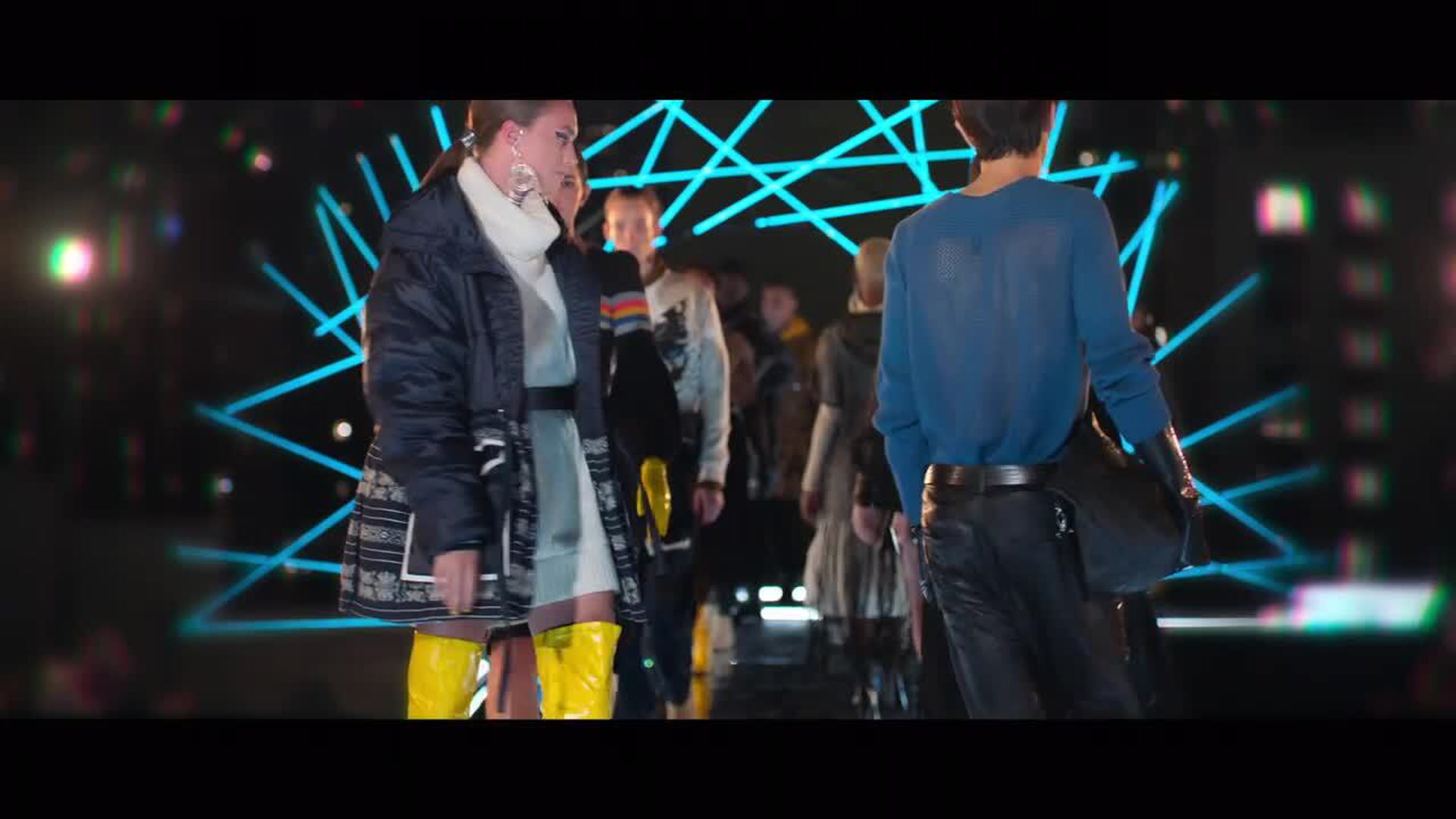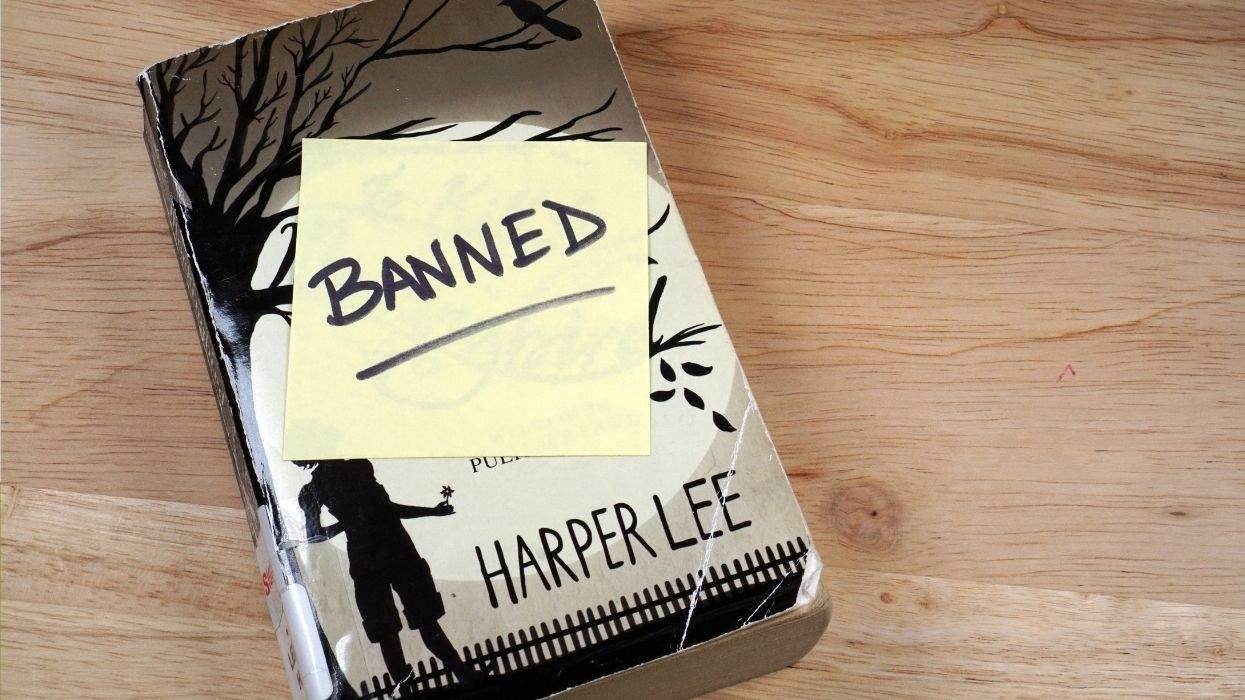WARNING: Making the Cut spoilers ahead.
It was a cutthroat last two episodes of Making the Cut, when finalists Sander Bos, Jonny Cota, and Esther Perbandt returned to New York City with a runway collection in tow and set up a pop-up shop.
Cota, with over a decade of experiencing running his label Skingraft, easily won over the judges with his shop's retail realness. Bos brought a tailor to his own colorful creation, but it was not enough to compete with Perbandt's blend of black couture and rope conjuring an art installation.

Pictured: Jonny Cota, Esther Perbandt, Sander Bos, and Tim Gunn
Ultimately, the finale pitted Cota against Perbandt in a dazzling runway show illuminated by the Big Apple skyline and blue lasers. Perbandt, true to form, stuck primarily with striking noir looks. Meanwhile, Cota showed off his growth as a designer this season by blending the hard-leather looks he traditionally loves with softer ensembles and splashes of design and color.
Adviser (and executive producer) Tim Gunn couldn't be a prouder mentor as he became emotional during the runway show. Earlier, he accompanied Cota and Perbandt as support in separate pitch meetings with Christine Beauchamp, president of Amazon Fashion, as each designer argued why their brand would be more successful with the e-commerce retailer's global audience.
However, the choice of Making the Cut's winner came down to the judges. As aired in the finale, it was a nailbiter, with Naomi Campbell and Heidi Klum supporting Perbandt and Joseph Altuzarra and Chiara Ferragni voting for Cota. Ultimately, Nicole Richie broke the tie, casting her vote for Cota, who as winner of the reality competition now has a namesake line available on Amazon as well as a $1 million prize to invest in his business.
Below, The Advocate spoke with Cota about his reaction to the win, how his experiences as a gay man inform his fashion, and the future of the fashion industry during a health crisis.
 Pictured: Heidi Klum, Jonny Cota, and Tim Gunn
Pictured: Heidi Klum, Jonny Cota, and Tim Gunn
The Advocate: Congratulations!
Jonny Cota: Thank you! It's a major freaking day.
Your small business loan came through, I hear.
[Laughs] Right? I'm one of the few.
How does it feel to win Making the Cut?
Life-changing. Winning Making the Cut, I guess this is one of the proudest moments of my life so far. It isn't just a prize. It is a validation of 15 years of hustling, to be honest.
Well deserved. What are you going to do with the money?
Gold teeth. [Laughs] I am going to invest the majority of the money into my brand, into launching my namesake label, into empowering Jonny Cota Studio to have its best opportunity on Amazon that it possibly can. You've seen the finale, I'm talking about a lot of sustainable goals for this new brand. And that takes capital. So I'm excited to invest in the most sustainable business practices that we can come up with.
 Pictured: Promotional shot from Jonny Cota Studio on Amazon
Pictured: Promotional shot from Jonny Cota Studio on Amazon
I loved seeing your journey on Making the Cut. How did the experience of being on the show influence who you are as a designer today?
I arrived on the show just thinking I was going to make beautiful leather garments like I've done for 10 years. I very quickly was kind of torn open by the judges, and I really had to soul search. Who am I as a designer? Who am I as an artist? Who am I as a business person? And that soul searching was really rewarding because I discovered parts of myself that I was either hiding or didn't even realize were there. Creative parts of my design ability or a certain drive in my entrepreneurial spirit that I kind of don't focus on daily. I just want to be an artist. But to have to stand in front of Christine Beauchamp and convince her to invest a million dollars in me? I mean, that takes drive, and I didn't necessarily identify that drive myself before the show.
That seemed like a really intense experience.
It was a lot, yeah. [Laughs]
I think one of my favorite moments on the show was when you stained the dress with coffee. It was a real throwback to ingenuity. What was going through your head in that moment?
It was a panic moment. And it was a pivot. But you know, the one thing I've learned after being a fashion designer for 15 years is pivot is power. I knew that [my] Tim Talk was not going to go well. I did not have a plan to dye the dress with the coffee until I saw the fear in Tim [Gunn]'s eyes. My scramble to figure out a solution really paid off. Watching the episode, I was like, damn, Cota, that was a really creative idea. It's something we all have in our kitchens, and it's something that's like, how can you make something great with something really accessible?
I've interviewed Tim Gunn a few times for the show. And I'm always so impressed by his wisdom and his gravitas. What's it like having him as a mentor, particularly as a gay man?
Incredible. I was starstruck the first time I met Tim. I was stumbling over my words. But he has this soft wisdom to him that is incomparable. I've never met anyone like him. By the end, I felt so close to him. I felt like how funny is it that this conservatively dressed, pristinely presented older man and this gothy, gay party kid somehow became really close friends on the show. We formed this really beautiful friendship along the way, and I will always value his presence in my life.

Is there a pearl of wisdom in particular that sticks out from his education and relationship?
What I learned most from Tim is that you can have a difference of opinion or a difference of style, but you can still appreciate quality. So pretend to come over and see some of my wildest designs and say, "Oh, I'm intrigued" [in Tim Gunn's voice]. I learned from him like to really set my personal views apart and to really be impartial and to see my brand aesthetic, the design aesthetics around me, from a neutral standpoint. That's, I think, the heart of Tim Gunn's wisdom.
On the show, you discussed how your experience as a gay man influenced your work -- this progression from armor, something to protect you, to do something more liberating by the end. Can you share how your queer perspective shapes the way that you make fashion?
As young queer people, we build up a lot of armor to protect ourselves. And it came out in my design aesthetic with Skingraft. It was fierce, leather, hard, stomping down the runway. And there is power to that. And that is beautiful. But on the show, I quickly started to get confronted with that feeling like a mask or like an armor that needed to be peeled away. And to peel away layers and layers that you've built up for years to protect yourself? That's a very vulnerable position to put yourself in. I was kind of having this Velvet Rage moment realizing that even though I love my aesthetic, so much of it was a form of protection and hardness. To peel back some of that, to show some of that feminine side, vulnerability, that softness was something I wasn't prepared to show. But I was excited to start expressing [that] in my designs and to the judges. They immediately responded to it.
 Pictured: Jonny Cota's final runway line
Pictured: Jonny Cota's final runway line
I was so impressed by how you and some of the other designers had gender-inclusive fashion on the runway. And in your new line, you're encouraging customers to think outside of the gender binary when choosing garments, which I also love. Is this a philosophy that's always governed your fashion or was this also an evolution?
A philosophy that has always governed my fashion is to be gender-inclusive. I've sent down countless male-identified models in dresses without even thinking about it. To be honest, I never want to brand my aesthetic as being gender-free or unisex. That's just a given. Go back to the aesthetic. Go back to the art. I've never really loved brands that make gender-free or gender inclusivity as the pillar of their business. OK, well, what else? It's always just been part of what I've done. And I want it to feel like a no-brainer. Now let's talk about the style.
Do you see that as the future of fashion? Years from now, will we look at separation between men and women as archaic?
I do see it as the future of fashion. I am so inspired by the younger generation that is more and more making those gender binaries feel obsolete, feeling like a thing of the past. So I champion that in my designs, and I think that that is exactly where fashion is going.
As a gay man, personally, it was really amazing to see your story and all the love that you had from your family. What does that support you know from your husband from your other family members mean to you as a designer and also as a person?
Well, I saw that I am an ugly crier. As a young gay man brought up in a religious family, in a religious household, in a conservative community, [you are] expected to go to college and just do the manly professions.
From an early age, once you realize you're gay, you realize that there is no path set in front of you to follow. And it's very scary. So to start my gay path, which feels like you're alone, and then to finish school and join the circus and to become a fashion designer, it was my greatest fear that my parents would just not be along for the ride, wouldn't be able to support it.
But I really am so grateful that even if they didn't see where I was going, they always loved me. And they always supported me. When I moved to L.A. to become a fashion designer, they were like, "You don't even sew! You don't even know anyone in L.A.!" It was just the most bonkers idea. So to see that moment on Making the Cut where I'm calling my family, I'm doing great in this international competition, they're helping my gay husband steam the clothes for my store, it was the most full-circle amazing moment of my gay life. If I could have told 13-year-old gay Jonny Cota that that would one day happen, I don't know if I'd believe it.
What message do you hope seeing that story sends to other viewers, especially in places where being gay is not embraced?
First off, I want to acknowledge that I am so lucky. I'm in a privileged position to have such support. And a lot of people, depending on where they live or what family they come from, they don't have that support. So hopefully, watching my story unfold on Making the Cut gives them this little ray of light of hope that you can chase your dreams, you can find love, you can find support. Focus on what makes you happy, and the rest will follow.
Fashion is one of the industries that really hard hit right now during the current health crisis. How do you as a designer respond to this new reality and this new marketplace?
Right now my number 1focus is my health, my safety, and for the people around me. It's an interesting challenge to keep your business running: To continue to be able to pay your team, you need to make sales, but to not sound tone-deaf while you are announcing new promotions with your brand. So for us, we teamed up with Tom of Finland. We did this big mask promotion last week. We sold over 200 masks. Of every mask sold, we donated one to the L.A. LGBT Center. So it's like, OK, you can continue to be a small business. You can continue to promote to your customers. But you better be talking about what's happening right now and you better be finding a way to help.
That's amazing, and I want one of those masks.
Me too! We sold out before I could even get one.
Where do you see yourself in five, 10 years?
I love fashion. I've been doing it for 15 years, and I was almost on my way out before I was approached by Making the Cut. I'm thrilled to put all my energy behind launching Jonny Cota, launching Jonny Cota Studio with Amazon. But my vision for the company is going to be so much more than fashion -- to go into lifestyle, going into products, going to so many other categories, and to finally come out from behind this curtain and find myself in this spotlight that Making the Cut has granted me. I would love to chase more opportunities in front of the camera.
Browse the Jonny Cota Studio on Amazon.com and revisit Cota's collection from the finale below. (Fellow finalist Perbandt is also launching a collection on Shopbop.com.) All episodes of Making the Cut are now available to stream on Amazon Prime Video.



 Pictured: Heidi Klum, Jonny Cota, and Tim Gunn
Pictured: Heidi Klum, Jonny Cota, and Tim Gunn Pictured: Promotional shot from Jonny Cota Studio on Amazon
Pictured: Promotional shot from Jonny Cota Studio on Amazon
 Pictured: Jonny Cota's final runway line
Pictured: Jonny Cota's final runway line



































































Charlie Kirk DID say stoning gay people was the 'perfect law' — and these other heinous quotes